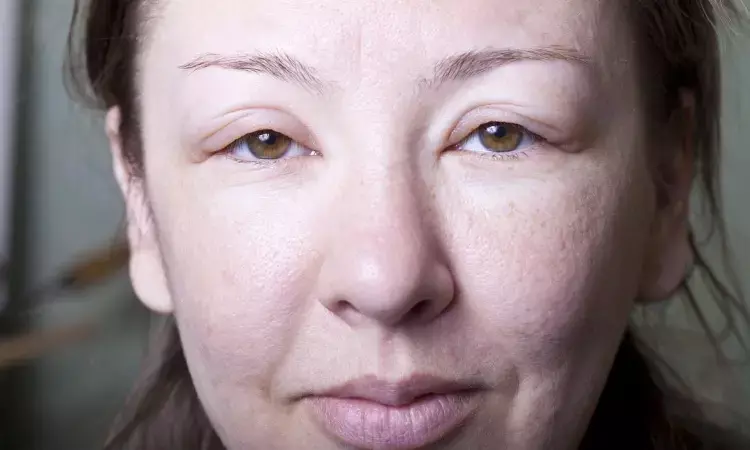- Home
- Medical news & Guidelines
- Anesthesiology
- Cardiology and CTVS
- Critical Care
- Dentistry
- Dermatology
- Diabetes and Endocrinology
- ENT
- Gastroenterology
- Medicine
- Nephrology
- Neurology
- Obstretics-Gynaecology
- Oncology
- Ophthalmology
- Orthopaedics
- Pediatrics-Neonatology
- Psychiatry
- Pulmonology
- Radiology
- Surgery
- Urology
- Laboratory Medicine
- Diet
- Nursing
- Paramedical
- Physiotherapy
- Health news
- Fact Check
- Bone Health Fact Check
- Brain Health Fact Check
- Cancer Related Fact Check
- Child Care Fact Check
- Dental and oral health fact check
- Diabetes and metabolic health fact check
- Diet and Nutrition Fact Check
- Eye and ENT Care Fact Check
- Fitness fact check
- Gut health fact check
- Heart health fact check
- Kidney health fact check
- Medical education fact check
- Men's health fact check
- Respiratory fact check
- Skin and hair care fact check
- Vaccine and Immunization fact check
- Women's health fact check
- AYUSH
- State News
- Andaman and Nicobar Islands
- Andhra Pradesh
- Arunachal Pradesh
- Assam
- Bihar
- Chandigarh
- Chattisgarh
- Dadra and Nagar Haveli
- Daman and Diu
- Delhi
- Goa
- Gujarat
- Haryana
- Himachal Pradesh
- Jammu & Kashmir
- Jharkhand
- Karnataka
- Kerala
- Ladakh
- Lakshadweep
- Madhya Pradesh
- Maharashtra
- Manipur
- Meghalaya
- Mizoram
- Nagaland
- Odisha
- Puducherry
- Punjab
- Rajasthan
- Sikkim
- Tamil Nadu
- Telangana
- Tripura
- Uttar Pradesh
- Uttrakhand
- West Bengal
- Medical Education
- Industry
Garadacimab efficacious prophylactic for patients with hereditary angioedema

Garadacimab is efficacious, subcutaneous prophylaxis in patients with hereditary angioedema (HAE-C1-INH), according to a recent study published in the Lancet.
Hereditary angioedema is associated with dysregulation of the kallikrein–kinin system. Factor XII (FXII) is a key initiator of the kallikrein–kinin system, which produces bradykinin, a central mediator of angioedema. Garadacimab (CSL Behring) is a first-in-class, fully human, immunoglobulin G4 monoclonal antibody targeting activated FXII, intended to prevent attacks in patients with C1-esterase inhibitor-deficient hereditary angioedema (HAE-C1-INH). We aimed to investigate garadacimab as a treatment every 4 weeks for patients with HAE-C1-INH.
In this double-blind, placebo-controlled, phase 2 study, patients with HAE-C1-INH were recruited from 12 research centres in Canada, Germany, Israel, and the USA. Eligible patients were aged 18–65 years and must have had at least four attacks of any severity over a consecutive 2-month period during the 3 months before screening or initiation of previous hereditary angioedema prophylaxis. After a run-in period of 4–8 weeks, patients were randomly assigned (1:1:1:1), using an interactive response technology via block randomisation (block sizes of 1–4), to either placebo or 75 mg, 200 mg, or 600 mg garadacimab. Patients were given an initial intravenous loading dose, and then, on day 6 and every 4 weeks for 12 weeks, they were given a subcutaneous dose of their allocated treatment. The primary endpoint was the number of monthly attacks in the intention-to-treat population (defined as all patients who underwent screening, provided consent, and were assigned to treatment) during the 12-week subcutaneous administration period assessed in the 200 mg and 600 mg garadacimab groups versus placebo. Safety was assessed in all patients who received at least one dose or the partial dose of study treatment.
The findings of the study are:
- Between Oct 29, 2018, and Aug 28, 2019, 54 patients were screened, of whom 32 were randomly assigned to either placebo (n=8) or 75 mg (n=9), 200 mg (n=8), or 600 mg (n=7) garadacimab.
- The median age was 39·5 years (28·0–52·5) and 18 (56%) of 32 patients were female and 14 (34%) were male.
- The median number of monthly attacks during the 12-week subcutaneous treatment period was 4·6 (IQR 3·1–5·0) with placebo, 0·0 (0·0–0·4) with 75 mg garadacimab, 0·0 (0·0–0·0) with 200 mg garadacimab, and 0·3 (0·0–0·7) with 600 mg garadacimab. Compared with placebo, the rate of attacks was significantly reduced with garadacimab at 200 mg (reduced by 100% [95% CI 98–101]; p=0·0002) and 600 mg (reduced by 93% [54–110]; p=0·0003).
- No serious adverse events, deaths, or adverse events of special interest (anaphylaxis, thromboembolic events, and bleeding events) were observed.
Thus, Garadacimab 200 mg and 600 mg every 4 weeks significantly reduced the number of monthly attacks versus placebo and was well tolerated during the study. Garadacimab is efficacious, subcutaneous prophylaxis in patients with HAE-C1-INH and warrants phase 3 evaluation.
Reference:
Prophylactic use of an anti-activated factor XII monoclonal antibody, garadacimab, for patients with C1-esterase inhibitor-deficient hereditary angioedema: a randomised, double-blind, placebo-controlled, phase 2 trial by Timothy Craig, et al. published in the Lancet.
DOI:https://doi.org/10.1016/S0140-6736(21)02225-X
Dr. Shravani Dali has completed her BDS from Pravara institute of medical sciences, loni. Following which she extensively worked in the healthcare sector for 2+ years. She has been actively involved in writing blogs in field of health and wellness. Currently she is pursuing her Masters of public health-health administration from Tata institute of social sciences. She can be contacted at editorial@medicaldialogues.in.
Dr Kamal Kant Kohli-MBBS, DTCD- a chest specialist with more than 30 years of practice and a flair for writing clinical articles, Dr Kamal Kant Kohli joined Medical Dialogues as a Chief Editor of Medical News. Besides writing articles, as an editor, he proofreads and verifies all the medical content published on Medical Dialogues including those coming from journals, studies,medical conferences,guidelines etc. Email: drkohli@medicaldialogues.in. Contact no. 011-43720751


